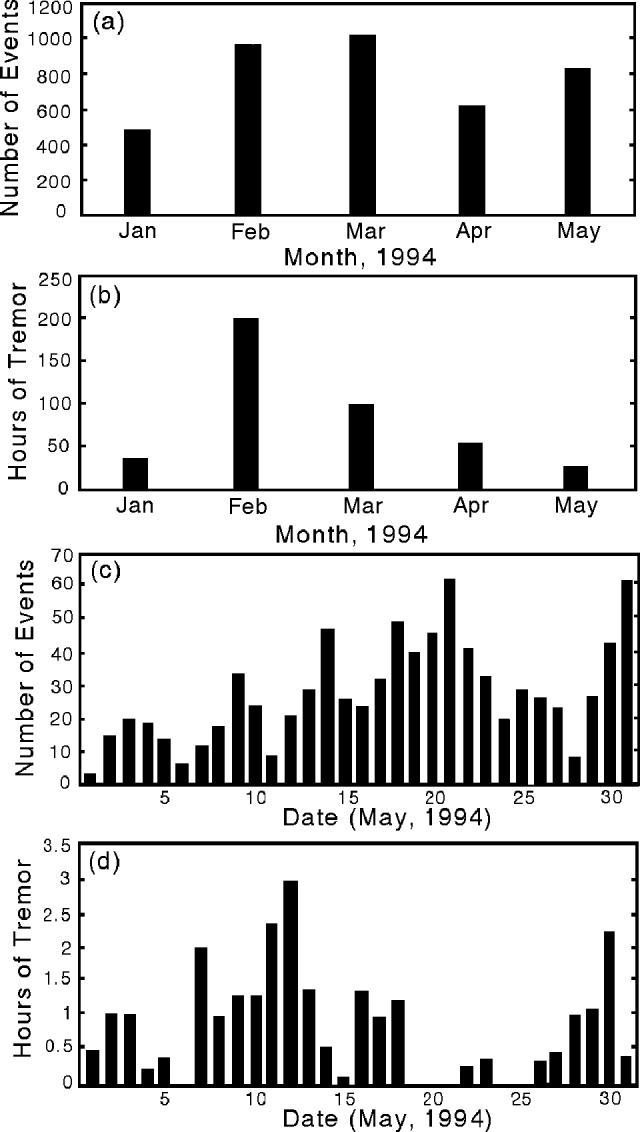Report on Arenal (Costa Rica) — May 1994
Bulletin of the Global Volcanism Network, vol. 19, no. 5 (May 1994)
Managing Editor: Richard Wunderman.
Arenal (Costa Rica) Lava flows, "mute" events, and damage from gas emissions
Please cite this report as:
Global Volcanism Program, 1994. Report on Arenal (Costa Rica) (Wunderman, R., ed.). Bulletin of the Global Volcanism Network, 19:5. Smithsonian Institution. https://doi.org/10.5479/si.GVP.BGVN199405-345033
Arenal
Costa Rica
10.463°N, 84.703°W; summit elev. 1670 m
All times are local (unless otherwise noted)
During May, Crater C continued its continuous emission of gases, lava flows, and sporadic Strombolian-style eruptions. The lava flows that began to exit in late December (1993) and late April (1994) both continued to move, but some of the smaller lobes had stopped. Though not erupting, Crater D maintained fumarolic activity.
During May, Strombolian eruptions remained low in number and magnitude. As in April, erupted ash reached 100-200 m above Crater C, but no explosive noises were evident ("mute" events). In late June, ICE geologists saw an average of one eruption every half hour, ejecting ash plumes up to 1,200 m above the crater.
During May, the OVSICORI seismic station ("VACR," located 2.7 km NE of the main crater) registered 831 events with frequencies of 1.7-2.3 Hz; the majority of these were associated with eruption of gas and pyroclastics (figure 69). The number of hours of harmonic tremor received for the month was relatively low (a total of 29 hours, figure 69c). Several peaks and troughs in seismic activity took place during the course of the month (figure 69c). The greatest duration of tremor took place around the 12th, when seismicity was moderate to low. A comparison with May data collected at the ICE seismic station ("La Fortuna," 3.5 km E of Crater C) shows good agreement in terms of seismic events and tremor near the middle of the month, but less agreement early and late in the month.
 |
Figure 69. Seismicity and duration of tremor at Arenal, as follows: (a and b) monthly summary for January-May 1994, (c and d) daily summary for May 1994. Courtesy of OVSICORI. |
During April and May, surveys of both a W-flank trigonometric-leveling line and the distance-measurement network showed no significant changes.
Geological Summary. Conical Volcán Arenal is the youngest stratovolcano in Costa Rica and one of its most active. The 1670-m-high andesitic volcano towers above the eastern shores of Lake Arenal, which has been enlarged by a hydroelectric project. Arenal lies along a volcanic chain that has migrated to the NW from the late-Pleistocene Los Perdidos lava domes through the Pleistocene-to-Holocene Chato volcano, which contains a 500-m-wide, lake-filled summit crater. The earliest known eruptions of Arenal took place about 7000 years ago, and it was active concurrently with Cerro Chato until the activity of Chato ended about 3500 years ago. Growth of Arenal has been characterized by periodic major explosive eruptions at several-hundred-year intervals and periods of lava effusion that armor the cone. An eruptive period that began with a major explosive eruption in 1968 ended in December 2010; continuous explosive activity accompanied by slow lava effusion and the occasional emission of pyroclastic flows characterized the eruption from vents at the summit and on the upper western flank.
Information Contacts: G. Soto, G. Alvarado, and F. Arias, ICE; H. Flores, Univ de Costa Rica; E. Fernández, J. Barquero, V. Barboza, and W. Jiménez, OVSICORI.

